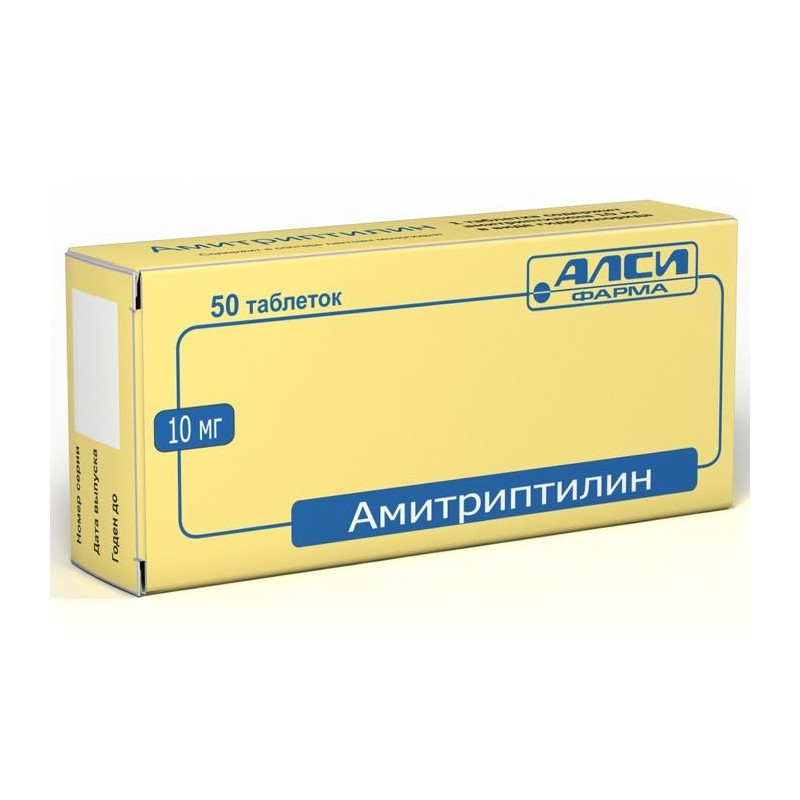



 All payments are encrypted via SSL
All payments are encrypted via SSL
 Full Refund if you haven't received your order
Full Refund if you haven't received your order
An antidepressant from the group of tricyclic compounds, a derivative of dibenzocycloheptadine. The antidepressant effect of Amitriptyline is associated with the stimulation of adrenergic and serotonergic mechanisms in the brain due to the inhibition of reverse neuronal capture of neurotransmitters. It has a sedative effect, has anticholinergic and antihistamine activity. The antidiuretic effect in case of bedwetting is due, apparently, anticholinergic activity. It has an analgesic effect, which is believed to be associated with changes in the concentrations of monoamines in the central nervous system, especially serotonin, and the effects of tricyclic antidepressants, including amitriptyline, on endogenous opioid systems.
Bioavailability of amitriptyline is 31-61%. Plasma protein binding 82-96%. The volume of distribution - 5-10 l / kg. Metabolized to form the active metabolite of nortriptyline.
The elimination half-life is 31-46 hours. Excreted mainly by the kidneys.
The depressive phase of manic-depressive psychosis, depression (including in childhood), mixed emotional disorders and behavioral disorders. Pediatric enuresis (with the exception of children with hypotonic bladder). Nervous bulimia.Chronic pain syndromes.
For oral administration, the initial dose is 25-50 mg at night. Then within 5-6 days, the dose is individually increased to 150-200 mg / day (most of the dose is taken at night). If there is no improvement during the second week, the daily dose is increased to 300 mg. With the disappearance of signs of depression, the dose is reduced to 50-100 mg / day and this therapy continues for at least 3 months. In old age with light disorders that are treated on an outpatient basis, the dose is 50-100 mg / day, usually 1 time / day for the night. With nocturnal enuresis in children - 12.5-25 mg at night. Children over 7 years old - 12.5-25 mg 1-3 times / day.
From the side of the central nervous system: drowsiness, disorientation, agitation, hallucinations, extrapyramidal disorders, tremors, fatigue are possible; rarely anxiety.
Cardiovascular: orthostatic hypotension, tachycardia, conduction disturbances.
Gastrointestinal: sour-bitter taste in the mouth, nausea, vomiting, stomatitis; rarely - cholestatic jaundice.
From the reproductive system: possible violation or delay ejaculation, reduced potency, changes in libido.
On the part of the endocrine system: rarely - hyperglycemia, glucosuria, impaired glucose tolerance, diabetes mellitus, syndrome of inadequate secretion of ADH.
Metabolism: possible increase in body weight.
Allergic reactions: possible skin rash, itching.
Effects due to anticholinergic activity: dry mouth, disturbance of accommodation, blurred vision, increased intraocular pressure, constipation, urinary retention.
Angle-closure glaucoma, prostatic hypertrophy, bladder atony, paralytic ileus, epilepsy, pyloric stenosis, early recovery period after myocardial infarction, simultaneous treatment with MAO inhibitors.
Amitriptyline should not be used during pregnancy, especially in semesters I and III, unless absolutely necessary. Adequate and well-controlled clinical studies of the safety of the use of amitriptyline during pregnancy have not been conducted.
In experimental studies, amitriptyline had a teratogenic effect in doses many times higher than clinical doses.
With caution used in ischemic heart disease, arrhythmias, heart failure. With a sharp cessation of admission may develop withdrawal syndrome.
Amitriptyline can be used no earlier than 14 days after discontinuation of MAO inhibitors.
It should not be used simultaneously with sympathomimetic agents, incl. with epinephrine, ephedrine, isoprenaline, norepinephrine, phenylephrine, phenylpropanolamine.
With caution used simultaneously with other drugs that have anticholinergic effects.
While taking amitriptyline alcohol is not allowed.
Influence on ability to drive motor transport and control mechanisms
During the period of treatment should refrain from potentially dangerous activities that require increased attention and quick psychomotor reactions.
Amitriptyline in the form of tablets, dragees, and solution for injection is included in the List of VED.
With the simultaneous use of amitriptyline and other drugs that have a depressant effect on the central nervous system, as well as with ethanol, a significant increase in the inhibitory effect on the central nervous system, hypotensive effect, and respiratory depression is possible; with other drugs with anticholinergic activity - increased anticholinergic effects; with sympathomimetic drugs - it is possible to increase their effect on the cardiovascular system and increase the risk of developing heart rhythm disorders, tachycardia, severe arterial hypertension; with clonidine, guanethidine - reduction of their hypotensive action is possible; with barbiturates, Carbamazepine - reducing the action of amitriptyline due to an increase in its metabolism; with quinidine - slowing of amitriptyline metabolism is possible.
With simultaneous use with cimetidine may slow the metabolism of amitriptyline, increasing plasma concentrations and the development of toxic effects.
Tricyclic antidepressants, including amitriptyline, increase the effect of alcohol, especially during the first few days of therapy.
